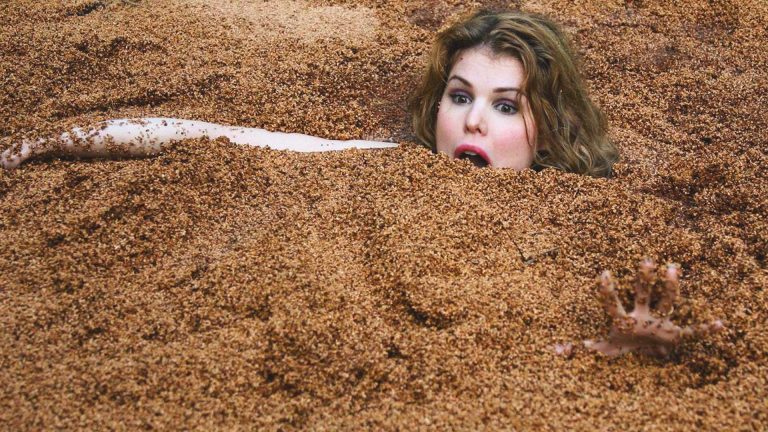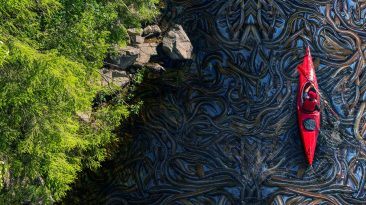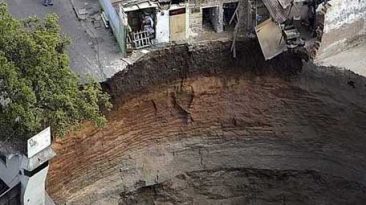Picture this, you’re having a nice, relaxing walk on a private beach without a care in the world. All of a sudden, your foot drops into a deep and mucky puddle. You struggle to pull your leg out, but it just won’t budge.
Before you know it, you’re sinking rapidly, and half of your body is submerged in cold, wet quicksand. The more you struggle, the more you sink. Talk about a terrible way to end a vacation.
You’ve probably seen people up to their neck in quicksand in the movies, but in real life, it’s quite rare. If you happened to slip in, you’d likely just sink halfway. Most of the time, quicksand isn’t actually that deep. But it can still be incredibly dangerous..
If you’re trapped and there’s no one around to help you, you could suffer hypothermia, dehydration or even suffocation.
You might also be an easy target for hungry predators. And if you’re close to water, watch out for the tides coming in or heavy rainfall. Hope you packed a snorkel!
How could you stay afloat in quicksand? What signs of quicksand should you look out for? Could you rescue yourself if you’re all alone?
Quicksand is found all over the planet, but is most common near coastal areas, marshes and riverbanks. There’s even dry quicksand that can be found in deserts.
Unlike mud or regular sand, quicksand is a Non-Newtonian fluid. Meaning, it’s solid in one state, but if anything agitates it, it quickly turns to liquid, causing you to sink deeper and deeper. So, what should you do in this scenario?
STEP ONE: Stop moving.
First things first, don’t panic and don’t move! Calm down and be as still as possible. The more you move, the deeper you will sink.
STEP TWO: Lighten the load.
If you have any bags, jackets or anything heavy on you, take them off and throw them away. I’m sorry, but it’s you or the bling. Less weight means you’ll sink less quickly.
STEP THREE: Grab onto something!
If you are with a friend, grab their hand, or grab hold of a tree branch nearby. Put as much weight as you can on the object you’re holding onto. This will slow down the sinking process and help you stay afloat.
STEP FOUR: Lean back and wiggle your feet.
Leaning back will increase your surface area, making it harder for you to sink. Wiggling your feet will help liquefy the sand and could help you free your legs. Once they are free, start paddling backwards with your arms to move yourself to solid ground. If your arms are stuck, try rolling your body instead.
STEP FIVE: Call for help.
If all else fails, your voice might be the only thing that can save you. Call for help, and if you can reach your phone, dial 911 immediately. You could suffocate if you’re stuck in there for too long.
STEP SIX: Breathe deeply.
This will make your body more buoyant. Try to meditate and focus on your breath. It’s time put those yoga classes to good use!
If you’re lucky, someone will come to the rescue, but they’ll need to be extra careful about pulling you out. They could rip you in half if they pull too hard. With quicksand being two times denser than humans, its suction is incredibly strong.
The weight of the sand can also damage your nerves and muscles. This is called Crush Syndrome, and can lead to the release of compounds that can harm your kidneys. So, it’s best to try and get your legs free and stay flat. This will alleviate pressure on your muscles and organs and let you safely return to the surface.
Dying from quicksand isn’t common, but it can still happen. Next time you’re travelling, educate yourself ahead of time about the dangers and risks in the surrounding area. Quicksand could be the least of your problems, especially if you’re lost in the Amazon jungle.
Subscribe to What-If on YouTube or follow the show on Facebook Watch.
Sources
- “What Is Quicksand? Learn How To Escape It”. 2020. Thoughtco.
- “Quicksand horror death of mother, 33, who drowned after getting trapped as the tide came in while on holiday in Antigua”. Narin, Jaya. 2012. Mail Online.
- “Surviving 12 Hours In Quicksand”. Spring, Joe. 2013. Outside Online.
- “Quicksand Science: Why It Traps, How To Escape”. 2005. nationalgeographic.com.


















